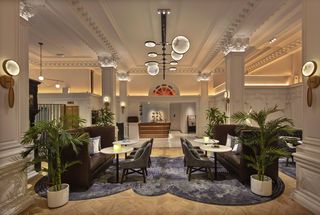The Algonquin Hotel Times Square, Autograph Collection
The Algonquin Hotel Times Square, Autograph Collection, Reopens Its Doors With Reimagined Food And Beverage Experiences
Reopening181 RoomsHotel websiteNew York Demand Trends

Today, The Algonquin Hotel Times Square, Autograph Collection welcomes back guests after closing its doors for a complete renovation of all public spaces. With more than a century of illustrious and unconventional history, The Algonquin Hotel, now managed by Highgate, debuts a new Lobby, Blue Bar Restaurant & Lounge and Oak Room, as well as brand-new food and beverage concepts.
As New York City's oldest continuously operating hotel, The Algonquin, which opened in 1902, provided plenty of historical inspiration for architecture and interior design firm Stonehill Taylor. The firm, which prides itself on its storytelling, emphasized narrative design to revitalize one of the most anticipated hotel reopening's in New York City. From the composition of My Fair Lady by Lerner and Loewe in one of its rooms to the establishment of The New Yorker, several of the hotel's notable moments were woven into the design narrative.
LOBBY AND RECEPTION
The renovation of The Algonquin is a confluence of old and new. An expansive, open lobby welcomes guests upon their arrival with original vaulted ceilings, woodwork and Corinthian-style columns outfitted in a fresh, brilliant ivory paint that brightens the room and is an emotional reveal to visitors and New Yorkers alike. Striking modern elements, such as new light fixtures and wall sconces, complement the hotel's original Beaux-Arts architecture. The new design details accentuate the historic elements of the property previously lost in the cavernous spaces of the hotel. To the right of the main entrance, the reception area features a new, sleekly designed desk with a curved, golden stepped base, hidden lighting and topped with blue and red veined marble. Behind the desk, a custom 3D art piece created from pages of books that belonged to hotel guests has been installed, further honoring past visitors.
The reception area would not be complete without a new home for the hotel's most beloved resident, its orange tabby cat, Hamlet VIII. The hotel has become synonymous with the various resident cats it has housed since the 1920s, when legend has it a stray cat wandered into the hotel and was taken in by hotel staff, who named it after famed hotel guest and Broadway actor John Barrymore, in honor of his greatest stage role. A private seating area featuring custom-made bookshelves and playful openings for guests to interact with Hamlet sits across from the reception area.
BLUE BAR RESTAURANT & LOUNGE
Originally conceived by John Barrymore, who famously quipped that actors looked best under blue lights, Blue Bar Restaurant & Lounge has welcomed patrons since the repeal of Prohibition. In a nod to the cocktail culture of yesteryear, made infamous by the collective Round Table witticisms, the updated menus will enliven classic beverages rooted in New York tradition and lore. Each drink is paying homage to mixologists, political and social figures and Algonquin legends dating back to the 1920's. A robust world wine program and tap cocktails will pair perfectly with a modern interpretation of classic bar dishes focused on sustainability and shareable items.
Relocated for the fourth time in the hotel's history, now the focal point of the Algonquin lobby, Blue Bar Restaurant & Lounge's signature indigo lighting remains a theatrical design element, creating a dramatic ambiance, complemented by backlit shelves that radiate powder blue and champagne-colored hues. The surrounding velvet banquettes and custom rugs in deep royal blue provide intimate spaces to people watch or settle in for an evening of old New York glamour.
Blue Bar Restaurant & Lounge is divided by landmarked columns and theatrical crushed velvet drapes, reminiscent of Broadway's curtain calls. The back of the restaurant can be sectioned off for private, catered events and The Algonquin is planning to revive the "Salon Spirit" of the space by booking local singers, dancers, burlesque performers, poets and authors to create new legendary experiences. The new space, in deference to the original and iconic Algonquin Round Table group of creatives, including Dorothy Parker and Alexander Woollcott, features a circular marble table illuminated by a chandelier inspired by the iconic velvet ropes that once kept the press and fans at bay. Through an exclusive partnership with the Al Hirschfeld Foundation, the space also features the American cartoonist's framed sketches of the Round Table personalities. Framed screens on either side of the bar will feature a rotation of classic and contemporary Hirschfeld artwork.
THE 'OAK ROOM' AND MEETING SPACE
The Algonquin's private event space, The Oak Room, has been expanded to 1,650 square feet with the ability to host groups of up to 105 people seated in theater style. If needed, the room can also be divided into two rooms, perfect for gatherings of groups of up to 40 people. The newly designed venue maintains the room's traditional oak wall paneling, refreshed and decorated with additional Hirschfeld pieces and paired with brilliant white accents to create playful movement in this contemporary meeting space, while still retaining The Oak Room's traditionally warm feel.
On the hotel's second floor, two meeting rooms have been updated with new, eight-seat boardroom tables in each and carpeting featuring patterns inspired by stacks of books. Adorning the walls are photos of Helen Hayes, known as the "First Lady of American Theater" and whose namesake theater neighbors the hotel on the same block. In the library, two bookshelves are filled with books signed by their authors. For decades, the hotel collected these books — and for an author, it would be considered an honor if their book was featured in the hotel's collection.
"We are so excited to mark a new chapter for this iconic New York hotel," says Willis Loughhead, General Manager of The Algonquin Hotel. "We look forward to inviting guests to experience its re-envisioned spaces that have been transformed with a fresh, modern take on a classical design that pays homage to the hotel's storied past and the theatrical and literary characters who frequented the hotel in the 1900s."
